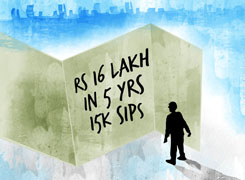Ramalingam Kalirajan |10893 Answers |Ask -Follow
Mutual Funds, Financial Planning Expert - Answered on Dec 18, 2024
He has an MBA in finance from the University of Madras and is a certified financial planner.
He is the director and chief financial planner at Holistic Investment, a Chennai-based firm that offers financial planning and wealth management advice.... more

Hello Sir.. I am 44 years old and don't have any investment but now wanted to invest in limited SIP and can invest 30K every month onwards for next 10 years Please suggest what amount and which SIP should I select?
Setting the Foundation: Your Investment Goals and Risk Appetite
Define Clear Goals
List your financial goals: retirement, children’s education, or wealth creation.
This helps in aligning investments with timelines and objectives.
Understand Your Risk Tolerance
At 44, you have a medium-term horizon of 10 years.
A mix of aggressive and moderate risk funds suits this duration.
Plan for Diversification
Diversification reduces risks and optimises returns.
Split investments into large-cap, mid-cap, small-cap, and hybrid funds.
Optimal Monthly Allocation of Rs. 30,000
Large-Cap Funds (Rs. 7,500)
Focus on stability with established companies.
Large-cap funds are resilient during market volatility.
Large and Mid-Cap Funds (Rs. 6,000)
Combine stability with moderate growth potential.
These funds are ideal for medium-term horizons.
Flexi-Cap Funds (Rs. 6,000)
Flexi-cap funds invest across market capitalisations.
They balance risk and growth, making them versatile.
Mid-Cap Funds (Rs. 5,000)
Mid-cap funds offer higher growth potential.
Invest for higher returns with a manageable level of risk.
ELSS Tax-Saving Funds (Rs. 5,500)
These funds provide tax benefits under Section 80C.
ELSS has a lock-in of 3 years and offers equity-like growth.
Benefits of SIP Investing
Rupee Cost Averaging
SIPs buy more units when markets fall and fewer when they rise.
This reduces the overall cost of investment over time.
Power of Compounding
Compounding grows wealth exponentially when you stay invested.
Reinvestment of returns boosts your corpus significantly.
Market Discipline
SIPs promote regular investments irrespective of market movements.
This ensures systematic wealth accumulation.
Active Fund Management Over Index Funds
Why Actively Managed Funds?
Actively managed funds outperform index funds over the long term.
Professional fund managers adapt to market trends effectively.
Drawbacks of Index Funds
Index funds lack flexibility during market downturns.
They mirror the index, limiting growth opportunities in bearish phases.
Benefits of Regular Plans with CFP Guidance
Regular plans come with advisory support and regular portfolio reviews.
A Certified Financial Planner ensures optimal fund selection and rebalancing.
Monitoring and Rebalancing Investments
Annual Portfolio Review
Review fund performance every year to ensure alignment with goals.
Replace underperforming funds promptly with better alternatives.
Asset Allocation Rebalancing
Adjust equity and debt exposure based on market conditions.
Move to safer options in the later years as you near your goal.
Tax-Efficient Withdrawals
Plan withdrawals systematically to minimise tax liabilities.
Use systematic withdrawal plans (SWPs) for tax-efficient regular income.
Building a Medical Corpus for Contingencies
Separate Health Fund
Allocate a part of savings for medical emergencies.
Health-related costs should not disturb your investment goals.
Health Insurance Optimisation
Even if health coverage is minimal, top-up plans can reduce financial stress.
Use your investment surplus for medical contingencies if needed.
Taxation of Mutual Funds
Equity Funds
LTCG above Rs. 1.25 lakh is taxed at 12.5%.
STCG is taxed at 20%.
Debt Funds
Gains are taxed based on your income tax slab.
Debt funds are best for risk-averse investors nearing retirement.
Tax-Saving ELSS Funds
ELSS investments help you save taxes under Section 80C.
They provide dual benefits of tax savings and long-term growth.
Preparing for Long-Term Financial Independence
Retirement Focus
Allocate part of your corpus to retirement.
Ensure a balance between immediate goals and post-retirement needs.
Emergency Fund Creation
Build a corpus for at least six months of expenses.
Keep it in a savings account or liquid fund for easy access.
Nomination and Will
Assign nominees for all investments.
Create a legally valid will to avoid complications in asset transfer.
Final Insights
Investing Rs. 30,000 monthly through SIPs is a disciplined approach to wealth creation. Diversify investments into equity-oriented funds for growth and tax-saving funds for benefits. Periodically review and adjust your portfolio for better results. Seek guidance from a Certified Financial Planner to ensure that your investments align with your long-term goals.
Best Regards,
K. Ramalingam, MBA, CFP,
Chief Financial Planner,
www.holisticinvestment.in
https://www.youtube.com/@HolisticInvestment
You may like to see similar questions and answers below
Sanjeev Govila | Answer |Ask -Follow
Financial Planner - Answered on Feb 08, 2023
Sanjeev Govila | Answer |Ask -Follow
Financial Planner - Answered on Feb 06, 2024
Ramalingam Kalirajan |10893 Answers |Ask -Follow
Mutual Funds, Financial Planning Expert - Answered on Apr 12, 2024
Ramalingam Kalirajan |10893 Answers |Ask -Follow
Mutual Funds, Financial Planning Expert - Answered on May 18, 2024
Ramalingam Kalirajan |10893 Answers |Ask -Follow
Mutual Funds, Financial Planning Expert - Answered on Oct 24, 2024
Ramalingam Kalirajan |10893 Answers |Ask -Follow
Mutual Funds, Financial Planning Expert - Answered on Dec 15, 2025
Ramalingam Kalirajan |10893 Answers |Ask -Follow
Mutual Funds, Financial Planning Expert - Answered on Dec 15, 2025
Radheshyam Zanwar |6746 Answers |Ask -Follow
MHT-CET, IIT-JEE, NEET-UG Expert - Answered on Dec 15, 2025
Ramalingam Kalirajan |10893 Answers |Ask -Follow
Mutual Funds, Financial Planning Expert - Answered on Dec 15, 2025
Ramalingam Kalirajan |10893 Answers |Ask -Follow
Mutual Funds, Financial Planning Expert - Answered on Dec 15, 2025
Ramalingam Kalirajan |10893 Answers |Ask -Follow
Mutual Funds, Financial Planning Expert - Answered on Dec 15, 2025
Samraat Jadhav |2508 Answers |Ask -Follow
Stock Market Expert - Answered on Dec 15, 2025
Ramalingam Kalirajan |10893 Answers |Ask -Follow
Mutual Funds, Financial Planning Expert - Answered on Dec 15, 2025
Reetika Sharma |425 Answers |Ask -Follow
Financial Planner, MF and Insurance Expert - Answered on Dec 15, 2025
Radheshyam Zanwar |6746 Answers |Ask -Follow
MHT-CET, IIT-JEE, NEET-UG Expert - Answered on Dec 15, 2025

























